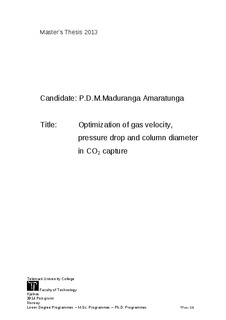| dc.contributor.author | Amaratunga, P. D. M. Maduranga | |
| dc.date.accessioned | 2015-09-18T09:17:32Z | |
| dc.date.accessioned | 2017-04-19T13:18:13Z | |
| dc.date.available | 2015-09-18T09:17:32Z | |
| dc.date.available | 2017-04-19T13:18:13Z | |
| dc.date.issued | 2015-09-18 | |
| dc.identifier.citation | Amaratunga,P.D.M.M.. Optimization of gas velocity, pressure drop and column diameter in CO2 capture. Master thesis, Telemark University College, 2013 | |
| dc.identifier.uri | http://hdl.handle.net/11250/2439044 | |
| dc.description.abstract | CO2 capture and storage (CCS) from fossil fuel fired power plants and also other large point sources is drawing increasing interest as a potential method for the control of greenhouse gas emissions. Among the different CCS technologies, post combustion capture of CO2 using amine based solvents is the most technically viable solution. The absorption column is the process unit that contributes to the highest cost in post combustion CO2 capture. Therefore optimization of the design parameters related to the absorption unit is very important. It is found very few references regarding the optimum design parameters such as pressure drop, gas velocity and column diameter in literature. In this study, a parameter optimization study for an absorption unit of an amine based CO2 capture process has been performed. The optimization has aimed to reduce the sum of estimated capital and operating costs by investigating the pressure drop through the packing, superficial gas velocity and hence the diameter of the absorber column. The structured packing, Mellapak 250Y was compared with 1” and 2” metal Pall Rings. The effective interfacial area for structured packing is varied according to some standard correlations and the packing height is dependent on effective interfacial area. With the main assumption that Mellapak 250Y and 1” Pall Rings have an effective interfacial area in the same order of magnitude and thus, the columns equipped with these two packings have similar packing height, the Mellapak 250Y with 2.0 m/s was calculated to be the optimum. According to the main assumption that Mellapak 250Y has an effective interfacial area twice the value compared to 2” Pall Rings and thus, only half the packing height is needed. Then a gas velocity of 2.5 m/s was calculated to be the optimum with Mellapak 250Y. An Aspen HYSYS simulation was carried out for the absorption unit to obtain data for other calculations. A CFD simulation was performed using ANSYS FLUENT 13.0 to visualize the initial gas mal-distribution of the packed columns. The k-Ɛ model was used and the packing region was modeled as a porous zone with porosity 0.95 and a viscous resistance 106 m-1. According to the results, the calculated optimum design parameters for the absorption column showed an even distribution for the gas phase and mal-distribution occurred at low gas velocities and low pressure drops. The work indicates that an optimum gas velocity is in the order of magnitude 2.0 to 2.5m/s and the pressure drop through the structured packing is in the order of magnitude 0.02 to 0.03 bar for large scale CO2 capture with traditional structured packing. To achieve more accurate optimum design parameters pilot or full scale performance data for pressure drop, gas velocity and effective interfacial area is probably necessary. | |
| dc.language.iso | eng | |
| dc.publisher | Høgskolen i Telemark | |
| dc.subject | Pressure drop | |
| dc.subject | Gas velocity | |
| dc.subject | Column diameter | |
| dc.subject | Structrured packing | |
| dc.subject | GFD | |
| dc.title | Optimization of gas velocity, pressure drop and column diameter in CO2 capture | |
| dc.type | Master thesis | no |
| dc.description.version | Published version | |
| dc.rights.holder | © Copyright The Author. All rights reserved | |
| dc.subject.nsi | 610 | |
